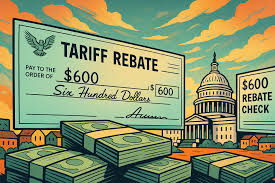
A new proposal in Congress has sparked nationwide interest—and for good reason. If passed, the American Worker Rebate Act could put $600 checks directly into the hands of eligible Americans, funded not by taxes, but by tariff revenues collected from foreign imports.
And as of late July 2025, that proposal is now officially on the table.
What Is the American Worker Rebate Act?
Introduced by Senator Josh Hawley on July 28, 2025, the American Worker Rebate Act aims to issue direct cash payments using money already collected through tariffs. These payments would be structured similarly to the COVID-19 stimulus checks.

The idea: since the U.S. government is collecting billions of dollars from tariffs on imported goods, some of that revenue should be returned to working Americans to help offset rising costs and inflation.
How Much Could You Get?
If passed, the proposed payments would be:
- $600 per adult
- $600 per child/dependent
A family of four could receive at least $2,400, and possibly more if tariff revenues exceed expectations. In June alone, the U.S. brought in around $27 billion in tariff revenue, and projections show that number could top $150 billion for fiscal year 2025.
Who Qualifies?
Eligibility would be similar to past stimulus checks, based on adjusted gross income:
- Individuals earning up to $75,000/year
- Heads of household up to $112,500/year
- Married couples filing jointly up to $150,000/year
The rebate amount would gradually phase out for people earning above those thresholds.
Where Is the Money Coming From?
The rebate would be funded entirely by tariff revenue—not new taxes. That means the money is already being collected by the government through duties on imports, including electronics, vehicles, clothing, and more.
Senator Hawley argues that since these tariffs are meant to protect American jobs and industry, it makes sense to return the benefits directly to American households.
Support & Opposition
Former President Donald Trump voiced support for the idea, saying:
“We have so much money coming in [from tariffs]; a little rebate … might be very nice.”

However, the bill is facing resistance within the Republican Party. Some GOP senators, including Ron Johnson and James Lankford, argue that the funds should go toward reducing the national debt, not issuing new payments. The U.S. national deficit has recently surpassed $36 trillion—a growing concern among fiscal conservatives.
Critics also point out that tariffs tend to raise prices for consumers, so the rebate may only provide temporary relief rather than solving the root of the problem.
What Happens Next?
While the bill has been introduced, it still has a long journey ahead:
- It must pass the Senate
- Then pass the House of Representatives
- And be signed by the President
With Congress currently in recess until early September, no vote is expected before then. Even if the bill gains momentum, payments likely wouldn’t arrive until late 2025 or early 2026, depending on when the legislation is finalized and the IRS begins distribution.
The American Worker Rebate Act is gaining traction as a bold approach to economic relief. By using existing trade revenue, it avoids adding to the national tax burden and aims to deliver targeted support to working-class families.
While the idea has political and economic hurdles to clear, it has opened up an important conversation about how tariff funds are used—and whether those dollars should go back to the people paying the highest price in today’s economy.
Stay tuned for more updates as the bill moves through Congress.












